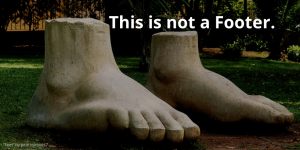What is a Successful Home Page?
For several years, I hosted an Austin Small Business networking group once a month over at Mangia Pizza at Mesa and Spicewood in North Austin. We discussed all things small business, marketing strategy, SEO Companies in Austin, Content Marketing, WordPress website best practices, etc… and tried to add value to the lives of Austin small business owners, startup pros and others as much as possible.
One month we talked Apps, another month, it’s all things Home Page and Content Marketing (Neil Patel was mentioned several times).
The Home Page discussions were very fruitful, so I thought I’d write a blog post about it.
What’s a Successful Homepage, you ask? If you’re asking what it is, you should probably read more.
What follow are some thoughts that might help you build a better and higher converting homepage. Here we go.
How Should Your Home Page and Content Marketing work Together?
First and foremost, a Homepage must make a visitor want to go deeper in the site. Why? Why not just put all of your goodies there on the first page and let the consumer dig through it and purchase from there?
Bad online marketer. No (pretend I have rolled-up newspaper).
Hopefully, that sentence gives you the answer. You don’t want your poor site visitor to be left to their own devices when it comes to deciphering your product or service solutions. Connecting your homepage and Content Marketing means that your Homepage points the way to a clear path that leads to a solution.
On other words, the job of a good homepage is to get your customer to LEAVE (but to exit to another page on your website!).
That’s the definition of a successful homepage.
Important: the homepage of your small business website is the first step in your Sales Process. It’s your greeting, and you have to get it right!
So now, let’s get to the list.
- Open. Your homepage should not feel cluttered, but open, inviting, with plenty of space here and there to keep it from feeling constricted. If you’re not trying to stuff everything onto it, this should not be difficult.
- Font. Since we’re talking about the aesthetic, let’s talk font. Put some study into the most popular fonts being used today (here’s a nice rabbit hole for you: when should you use serif fonts, and when san serif?). Readability is important, but conversion is even more important. You’ll see that word keep popping up as we go through this list.
- Use a Footer. This points to the next point on the list, but let’s talk footer and why. First, a footer gives
 you the ability to include central links and a few other core ideas (like your Social Media profiles) on every page. It’s also very good for SEO, though the links being on every page is good for SEO (free SEO Scan here), as well. You can also include your NAP (name, address, phone) info, which is great for Google Local, or whatever they’ve renamed it this week.
you the ability to include central links and a few other core ideas (like your Social Media profiles) on every page. It’s also very good for SEO, though the links being on every page is good for SEO (free SEO Scan here), as well. You can also include your NAP (name, address, phone) info, which is great for Google Local, or whatever they’ve renamed it this week. - Use WordPress. “Oh, no! Joomla is MUCH better!” “NO, NO, DRUPAL. USE DRUPAL NOW!!!” These are almost always designer types that will tell you this. Matter of fact, I would always ask someone who is recommending Drupal or some other platform (other than WP) if they are a designer.
If you’re not a designer, use WordPress. Footers are easy to install and edit, as well as page elements, images and many other tools.
Google loves WordPress (our Austin SEO Service depends on it) when it’s used properly, and it’s because it’s easy to read for search engine bots. Your homepage is relatively easy to edit in WordPress as well, though you would do yourself a giant favor if you hired a designer to set up this and a few other things. Talk to a designer, they’ll know. Here’s a Youtube Video where Matt Cutts discusses the value of WordPress:Matt Cutts Talks About WordPress
- Pay attention to colors. Color, by itself or in combination, is huge in keeping eyes on your page. If you’re not aesthetically gifted, you should hire a designer for at least a consulting gig just to get you on the right track. Again, conversion rears its ugly, or beautiful, head.
- Use Buttons. One of the great things about being in business with a website in our time is that you have access to tons of data about the use of buttons and how they track in analytics & Conversion, so Google that stuff, and then read it (I always defer to Brian Massey of Conversion Sciences on Conversion. Here’s their blog).
- Speaking of Google Analytics, make sure that you have trackable elements on your homepage. Though most business owners freak out about it, I highly recommend using a trackable phone number on your homepage, and a different one on deep landing pages. Since Google began masking the keyword data, you’re less able to see what goes on page to page on your site, though they have been improving this steadily. Still, if you have buttons that lead to specific pages, it’s far easier to track that in Google Analytics.
- Use a set of Slider Images. Or Don’t. Depending on your purpose, sliders are good for you or they’re not. There’s lots of data out there on this subject, and marketers differ. I happen to like sliders a lot. It gives your visitor a different face, and as they scroll, it changes, drawing the eye to a new idea. In either case, read up on it, then decide; don’t just wing it. Update: (I wrote this a few years ago) Sliders are far less useful in the age of Mobile-Friendly Websites (or Mobile Responsive Websites). I will write more on this in another post. Bottom Line: if your prospects tend toward desktop, use sliders. If not, don’t.
- Vector your images. Vector Images stay sharp as they are scaled up or down, generally speaking, and nothing is a bigger turn off to a visitor than a pixelated image. This ain’t 1994, people. This is a BIG one when moving from mobile to desktop, and vice versa. BIG Conversion killer.

- Know who you are. You should have a solid understanding of the 4 or 5 problems you solve for your clients (few businesses only solve one. If you think you solve one problem, you probably haven’t dug deep enough). This creates your Value Propositions. Then, talk about those problems on the home page. Don’t talk as much about the solution, that’s why they go to the deeper page. Let them decide that “yeah, I DO have that problem!”. Very important. That leads to the next point.
- Make it easy. Far too many business owners blather on about this or that, usually about how long they have been in business, or awards they’ve won, but even more prominent is the verbose homepage. Tons of content that just doesn’t say much is probably the number one reason for visitors bouncing (Google’s definition of Bounce Rate).Can’t find what I need? I’m out.
Bland content? GET TO THA CHOPPAH!!!

- EMAIL LIST! Have a giveaway of some valuable piece of content, and get visitors to sign up on an email list (foundational in email marketing). Then, TREAT THEM WELL. Only email them when you have something good to talk to them about. Don’t go to some seminar, then start pounding them with generic info just to email them. Remember: Always Add Value.
- Contact. Your Home Page should have clear, easy to find Contact info. I can’t over-emphasize this, SOCIAL BUTTONS. Make sure your social media accounts are linked through branded buttons on your Home page (foundational in Social Media Marketing). Have a good contact page. Try to get more granular than just “name, address, phone number”. Most WordPress Themes are fairly sophisticated when it comes to this, and will some tool they can use, like a dropdown, where you can have the visitor indicate what service they are interested in. This is important, not just for you, but it makes the visitor feel like you care a little more. Remember, they’ve visited a lot of other sites before yours. They will recognize when you have put a little more work in.
- Copyright date. Make sure this is current, and that it’s in the footer. It’s such a small detail, but it looks unkept if yours is out of date. Very easy to fix.
- Privacy Policy. If you’re not fairly savvy with online marketing minutia, you might not have heard about this, but it’s something that has become very important. In fact, Google will punish your site in Adwords by making your spend higher if you don’t have one, or it’s bad (check out Google Adwords Quality Score). In short, have a Privacy Policy that is tailored to your business, and link to it from your homepage. Commonly, you would link from under your About Us section as well as from the footer.
- Logo. Like your images, you should vector your logo, and for the same reasons. Also, pay attention to the NAME of the image you use for your logo. Don’t name it “mylogo_final_v1.3.4.7_thursday”. If you do, you miss a valuable, if small, conversion opportunity. Why not “Frontburner Marketing, Austin and Dallas Small Business Marketing” or something similar? See the difference? When site visitors mouse over your logo, they don’t see a messy image name, but a relevant keyword for your site.
 Social Media. Make sure your icons are high on the page. Don’t stick them in the footer and hope. It’s a good idea to keep the icons in their original colors, because they’re recognizable and will convert better. Have them open in a new page. VERY important. You don’t want to depend on your prospect to remember to hit the back button to get back to your website after looking at their sister’s new kittens. You’ll lose every time.
Social Media. Make sure your icons are high on the page. Don’t stick them in the footer and hope. It’s a good idea to keep the icons in their original colors, because they’re recognizable and will convert better. Have them open in a new page. VERY important. You don’t want to depend on your prospect to remember to hit the back button to get back to your website after looking at their sister’s new kittens. You’ll lose every time.- Optimize for Mobile. This is a huge rabbit hole, and if you don’t have deep understanding in this area, hire a pro. You don’t want to mess this up. In a recent experiment for a client, we advertised on Facebook and got 100 hits. 98 were from mobile (UPDATE: #MobileGeddon has arrived. Check it out).
- Social Proof. If you haven’t studied Social Proof, get into it. It’s THE reason for the explosion in both Social Media and the rise of the review industry. Your prospect is saying to you, “Prove to me that I’m safe in doing business with you by showing others like me who’ve done business with you and had a great experience.”
There’s lots more we could cover about the Homepage and Content Marketing, but we’ll stop at 19.
Unless I think of more that should be included.
But I probably won’t, because I’m tired.
I gotta go work on actual Homepages.
Seeya, homes. See what I did there?
Happy Marketing!


